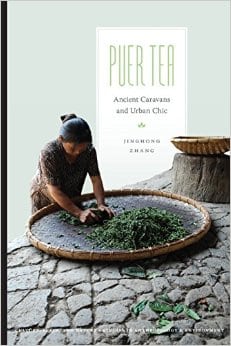 In the wake of the current Verdant Tea scandal, this seems like the perfect read. I started this book a little before the VTF, but juggling schoolwork and leisure reading, I haven’t really gotten to finishing it until recently. And I guess it’s perfect timing, because I think it’s a very relevant read to understanding the current drama. I won’t really be touching on that, because there are already half a dozen other tea-blogs that have covered it in depth, plus threads on TeaChat, r/tea, and Steepster to chronolog the drama (here’s Steepster’s to get you started, if you really haven’t been following the drama).
In the wake of the current Verdant Tea scandal, this seems like the perfect read. I started this book a little before the VTF, but juggling schoolwork and leisure reading, I haven’t really gotten to finishing it until recently. And I guess it’s perfect timing, because I think it’s a very relevant read to understanding the current drama. I won’t really be touching on that, because there are already half a dozen other tea-blogs that have covered it in depth, plus threads on TeaChat, r/tea, and Steepster to chronolog the drama (here’s Steepster’s to get you started, if you really haven’t been following the drama).
AC&UC isn’t so much a book about the facts of puer tea as it is about the author’s journey through Yunnan learning about the effect the tea has on people. It documents the rise and fall of puer tea during the boom/bust of 2007, and basically elaborates on the cultural feelings and tradition surrounding the “authentic” drink of Yunnan.
She spends a lot of time visiting and questioning the different definitions of the authenticity of puer tea, which is itself not very concrete and one of the many reasons puer tea is so open to forgery. She describes the tea as jianghu, a word that’s apparently difficult to pin down with a definition, but describes a wandering soul, knight or hermit; I’ll be honest, by the end of the book I still wasn’t particularly sure I grasped the meaning. But even with my particularly limited puer experiences I’ve seen how transient puer is.
Puer’s questionable authenticity and antiquity is further reflected in it’s rather short life in recent years, versus its claim to fame as one of the oldest forms of tea in China. Shu, or artificially fermented puer tea, was only invented in 1973. In contrast, the return of ‘authentic’ sheng puer, according to Zhang, was revived in the 1990s when Taiwanese and Hong Kong natives traveled to Yunna, bringing old raw puers from as late as the 1920s. Since only shu was being produced (and terrace tea was becoming the norm, wild trees having been heavily pollarded in the 80s), sheng production was re-taught by looking at antique compressed tea. Thus ironically, the non-native puer-nerds taught the native masters how to produce tea. I feel like it was a little more complicated than that, and I’m interested in learning more; however, the number of puer resources in English are slim to none.
The author uses this topic though to lead into the nostalgic draw of puer, the ‘drinkable antique’; it’s not just an antique, it’s vintage. In the hipster sense of the word–it’s nostalgia for something you weren’t alive to be nostalgic for. You buy it used, but it’s new to you; you’re buying for the history. I can kind of understand this on a different level, as a collector of old videogames (specifically the NES); they’re ‘playable antiques’. You don’t collect them just to display, or else you shouldn’t care if the hardware works or not. You collect them to play and show off and share, just as people collect puer tea to age, drink, and invest in. At least in my case I grew up playing the same games I collect today.
For the new puer drinker, especially a westerner, I feel this book is a good stepping stone to learning about the drink. It helps to ground puer tea, and dispel some of the mystique. Zhang pierces that commonly held illusion that puer tea is magical and untouchable, by telling you its very common history and introducing you to the players. Both in the industry, growing maocha, and in the high-end collectors. She’s not in herself a part of the fanaticism, and not overly enchanted by puer, so the result is a very straight forward and interesting tale. Jinghong Zhang is a post-doctorate and lecturer, but this definitely doesn’t read like a textbook. There aren’t many English puer books, so it’s generally agreed upon to grab this one if you can.




24/12/2015 at 11:12 PM
A scandal? I didn’t know or look at it.
It sounds really like an interesting book and the ” It documents the rise and fall of puer tea during the boom/bust of 2007″ makes all this sounds like the Tulip mania (https://en.wikipedia.org/wiki/Tulip_mania).
03/01/2016 at 8:57 AM
Ha! It really does read a bit like that.